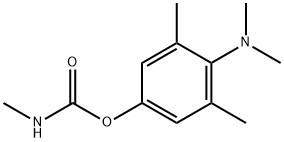?????? C??? ??, ??, ??
??? ??
Colorless crystals. Soluble inacetone, alcohol, and benzene; insoluble in water.
??
Pesticide for use in the control of snails and slugs.
??
Insecticides containing
4-dimethylamino-3,5-xylyl-n-methylcarbamate.
?? ??
ZECTRAN is an odorless white crystalline solid dissolved in a liquid carrier. ZECTRAN is toxic by inhalation, skin absorption, and/or ingestion. When heated to high temperatures ZECTRAN may emit toxic oxides of nitrogen. ZECTRAN will burn but ZECTRAN is difficult to ignite. ZECTRAN is used as a pesticide.
?? ???
ZECTRAN is a carbamate ester-amine. Amines behave as chemical bases. Carbamates are chemically similar to, but more reactive than amides. Like amides they form polymers such as polyurethane resins. Carbamates are incompatible with strong acids and bases, and especially incompatible with strong reducing agents such as hydrides. Flammable gaseous hydrogen is produced by the combination of active metals or nitrides with carbamates. Strongly oxidizing acids, peroxides, and hydroperoxides are incompatible with carbamates.
???
Toxic by ingestion.
????
Extremely toxic: probable oral lethal dose for humans is 5-50 mg/kg; between 7 drops and 1 teaspoonful for 70 kg person (150 lb.). (Non-Specific -- Carbamate Pesticide, Solid, n.o.s.) Poisonous; may be fatal if inhaled, swallowed, or absorbed through skin. Contact may cause burns to skin and eyes.
????
(Non-Specific -- Carbamate Pesticide, Solid, n.o.s.) Fire may produce irritating or poisonous gases. ZECTRAN may burn but does not ignite readily. Container may explode in heat of fire. When heated to decomposition ZECTRAN emits toxic fumes of nitrogen oxides. Avoid decomposition in highly alkaline media. Subject to photo-decomposition in the solid state.
???
Insecticide, Molluscicide: It is a insecticide and molluscicide for non-agricultural
uses, e.g., lawn and turf, flowers, gardens, vines,
forest lands, woody shrubs and trees. It is not used commercially
in the U.S. Not listed for use in EU countries.
There are 14 global suppliers.
???
DOWCO® 139)[C]; ZACTRAN®;
ZECTANE®; ZECTRAN®; ZEXTRAN®
Safety Profile
Poison by ingestion,
skin contact, and intraperitoneal routes.
Experimental teratogenic effects.
Questionable carcinogen with experimental
neoplastigenic data. When heated to
decomposition it emits toxic fumes of NOx.
See also ESTERS and CARBAMATES.
??? ??
It is an insecticide for nonagricultural
uses, e.g., lawn and turf, flowers, gardens, vines, forest
lands; woody shrubs and trees; and also a molluscicide.
It is not produced or used commercially in the United States.
Incompatibilities: Alkalis, strong oxidizers.
?? ??
UN2757 Carbamate pesticides, solid, toxic,
Hazard Class: 6.1; Labels: 6.1-Poisonous materials.
? ???
It is an insecticide for nonagricultural
uses, e.g., lawn and turf, flowers, gardens, vines, forest
lands; woody shrubs and trees; and also a molluscicide.
It is not produced or used commercially in the United States.
Incompatibilities: Alkalis, strong oxidizers.
??? ??
Consult with environmental
regulatory agencies for guidance on acceptable disposal
practices. Generators of waste containing this contaminant
(≥100 kg/mo) must conform to EPA regulations
governing storage, transportation, treatment, and waste
disposal. In accordance with 40CFR165, follow recommendations
for the disposal of pesticides and pesticide
containers. Must be disposed properly by following package
label directions or by contacting your local or federal
environmental control agency, or by contacting your
regional EPA office.
?????? ?? ?? ? ???
???
?? ??








